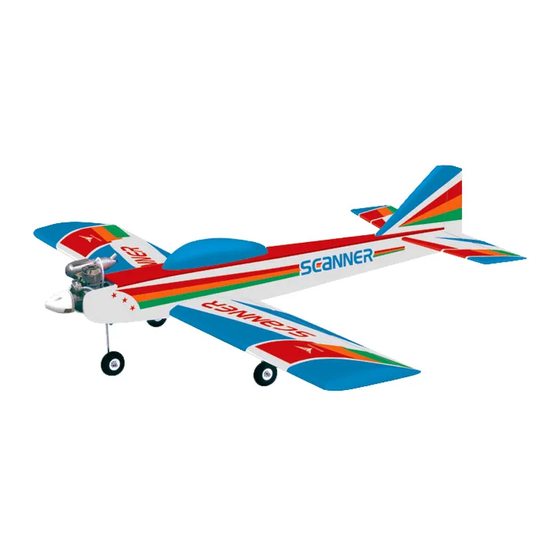
Table of Contents
Advertisement
Quick Links
I n s t r u c t i o n M a n u a l
g
We wish you many enjoyable flights with your plane and one again thank you for your choosing a Phoenix Model products.
ALMOST READY TO FLY
Wingspan : 1444mm (56.85 inches)
Length
: 1195mm (47.05 inches)
Weight
: 2400gr
Engine
: 40 - 46 two stroke / 48 - 53 four stroke
Radio
: 4 channel 5 servos
Advertisement
Table of Contents

Summary of Contents for Phoenix Model Scanner
- Page 1 Engine : 40 - 46 two stroke / 48 - 53 four stroke Radio : 4 channel 5 servos We wish you many enjoyable flights with your plane and one again thank you for your choosing a Phoenix Model products.
- Page 2 Fill out the consumer feedback survey at the end of the manual, send us a letter or contact us on the Internet. Again, thank you for purchasing the Scanner ARF by Phoenix Model.
- Page 3 Instruction Manual Scanner KIT CONTENTS: We have organized the parts as they come out of the box for better identification during assembly. We recommend that you regroup the parts in the same manner. This will ensure you have all of parts required before you begin assembly.
- Page 4 **NOTE** Please trial fit all the parts. Make sure you have the correct parts and that they fit and are aligned properly before gluing! This will assure proper assembly. Since the Scanner ARF is hand made from natural materials, every plane is unique and minor adjustments may have to be made.
- Page 5 Instruction Manual Scanner To the cowl 7. Using masking tape, tape the servo leads on to 2. Attach the clevis to the outer hole in the control the top of the wing. horn. Install a silicone tube on the clevis.
- Page 6 Instruction Manual Scanner 2) Test fit the dihedral brace into each wing half. The brace should slide in easily up to the centerline you drew. If it does not, use 220 grit sandpaper with a sanding block and sand down...
- Page 7 Instruction Manual Scanner Glue with epoxy 2) Bolt the wing to the fuselage. Set the 7) Mix a generous amount of 30 minute epoxy. horizontal stabilizer onto the stabilizer mounting Coat the exposed half of the dihedral brace, the platform on the fuselage. To align the horizontal wing joiner box and both root ribs with epoxy.
- Page 8 Instruction Manual Scanner 5) Remove the horizontal stabilizer. Using the 2) Remove the muffler from the engine and set lines you just drew as a guide, carefully remove the engine in the mount. Adjust the depth of the the covering from between them, using a engine in the mount.
- Page 9 Instruction Manual Scanner 2) There are two hardwood landing gear blocks 6) The preinstalled wire steering pushrod has a with one precut channel in each block in the factory made Z-Bend on the front end of it. bottom of the wing. Locate the two landing gear Connect the nylon steering arm to this pushrod.
- Page 10 Instruction Manual Scanner 9) Use pieces of the foam provided to hold the tank in place. Be careful the tank or the foam Vent tube Stopper assembly doesn't interfere with the pushrods. Fuel line 10) Connect the fuel pick-up line to the...
- Page 11 Instruction Manual Scanner 2) The control horn of elevator should be mounted 2) Using a modeling knife, remove the covering on the bottom, right side of the elevator at the from over the two precut pushrod slots, one on leading edge, each side of the fuselage, under the rear half of in line with the elevator pushrod.
- Page 12 Instruction Manual Scanner 8) Connect the servo to your radio's receiver and turn on the system. Set the trim tabs on the transmitter to neutral and center the servo arms. The elevator and rudder servo arms should be perpendicular to the servos. For the throttle, we...
- Page 13 If it does not, flip the servo reversing 3) Turn the Scanner upside down and place your switch on your transmitter to change the fingers on the marks on top of the wing and direction.
- Page 14 Land slightly faster than the stall speed and on the main wheels, as this is the easiest way to land the Scanner and will reduce the risk of stalling the airplane.
- Page 15 Instruction Manual Scanner I/C FLIGHT WARNINGS Always operate in open areas, away Keep all onlookers (especially small from factories, hospitals, schools, THE PROPELLER IS DANGEROUS children and animals) well back from buildings and houses etc. NEVER fly Keep fingers, clothing (ties, shirt the area of operation.
- Page 16 I/C FLIGHT GUIDELINES Operate the control sticks on the When ready to fly, first extend the transmitter and check that the control transmitter aerial. surfaces move freely and in the ALWAYS land the model INTO the CORRECT directions. wind, this ensures that the model lands at the slowest possible speed.
















Need help?
Do you have a question about the Scanner and is the answer not in the manual?
Questions and answers